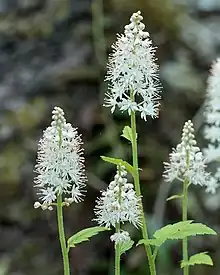Tiarella austrina
Tiarella austrina is a species of flowering plant in the family Saxifragaceae.[2] The specific name austrina means "from the south".[3] Being endemic to the southeastern United States, it is sometimes referred to as the southern foamflower.[4][5] It is one of two species of Tiarella that spread by stolons (the other being Tiarella stolonifera).
| Tiarella austrina | |
|---|---|
 | |
| Transylvania County, North Carolina, USA (April 24) | |
| Scientific classification | |
| Kingdom: | Plantae |
| Clade: | Tracheophytes |
| Clade: | Angiosperms |
| Clade: | Eudicots |
| Order: | Saxifragales |
| Family: | Saxifragaceae |
| Genus: | Tiarella |
| Species: | T. austrina |
| Binomial name | |
| Tiarella austrina | |
| Synonyms[2] | |
|
T. austrina
| |
Description
Tiarella austrina is a perennial, herbaceous plant with a short, slender rhizome. It has a leafy flowering stem and relatively large basal leaves with an extended terminal lobe.[6] Most importantly, the species has the ability to produce stolons.
Identification
To positively identify Tiarella austrina, all of the following key features must be verified (in any order):[6][7]
- Stolon present
- Basal leaves usually longer than wide
- Basal leaf lobes usually acute-acuminate with the terminal lobe prominently extended
- Flowering stem usually with 1–2 leaves or foliaceous bracts
The key features listed above are similar to those of Tiarella nautila but the presence of the stolon rules out that species.
Taxonomy
In 1937, Olga Lakela described Tiarella cordifolia var. austrina, a variety of T. cordifolia with stolons.[8] Guy Nesom raised this variety to species rank in 2021.[9] Consequently, Tiarella cordifolia var. austrina Lakela is a basionym for Tiarella austrina (Lakela) G.L.Nesom.[1]
Distribution
In eastern North America, Tiarella austrina is narrowly endemic to the southeastern United States where it occurs mainly in the southern Blue Ridge Mountains of southwestern North Carolina, southeastern Tennessee, northeastern Georgia, and northwestern South Carolina. Counties where the species is known to occur include:[10]
- Alabama: Jackson, Madison
- Georgia: Dawson, Habersham, Rabun, Stephens, Towns, White
- North Carolina: Buncombe, Cherokee, Clay, Graham, Haywood, Henderson, Jackson, Macon, Polk, Swain, Transylvania
- South Carolina: Greenville, Oconee, Pickens
- Tennessee: Blount, Cocke, Franklin, Monroe, Sevier
The ranges of Tiarella austrina and Tiarella nautila overlap in Georgia (Dawson, Towns, White), North Carolina (Cherokee), and Tennessee (Monroe).[11] Both Tiarella austrina and Tiarella stolonifera occur in Buncombe County, North Carolina. A small disjunct population of T. austrina overlaps Tiarella wherryi in northeastern Alabama (Jackson, Madison) and adjacent south-central Tennessee (Franklin).[10]
Conservation
The global conservation status of Tiarella austrina is unknown. It is uncommon (S3) in North Carolina.[5]
References
- "Tiarella austrina (Lakela) G.L.Nesom". International Plant Names Index (IPNI). Royal Botanic Gardens, Kew; Harvard University Herbaria & Libraries; Australian National Botanic Gardens. Retrieved 23 October 2022.
- "Tiarella austrina (Lakela) G.L.Nesom". Plants of the World Online. Royal Botanic Gardens, Kew. Retrieved 14 November 2022.
- Gledhill, David (2008). The Names of Plants (4th ed.). Cambridge University Press. p. 62. ISBN 978-0-521-86645-3.
- "Tiarella". Alabama Plant Atlas. Retrieved 20 October 2022.
- "Plant List". Vascular Plants of North Carolina. North Carolina Biodiversity Project. Retrieved 16 November 2022.
- Nesom (2021), p. 8.
- Weakley & Southeastern Flora Team (2022), p. 675.
- Lakela (1937).
- Nesom (2021).
- Nesom (2021), pp. 1, 10.
- Nesom (2021), p. 11.
Bibliography
- Lakela, Olga (1937). "A monograph of the genus Tiarella L. in North America". Amer. J. Bot. 24: 344–351.
- Nesom, Guy L. (2021). "Taxonomy of Tiarella (Saxifragaceae) in the eastern USA" (PDF). Phytoneuron. 31: 1–61. ISSN 2153-733X. Retrieved 28 October 2022.
- Weakley, Alan S.; Southeastern Flora Team (2022). "Flora of the southeastern United States". University of North Carolina Herbarium, North Carolina Botanical Garden.